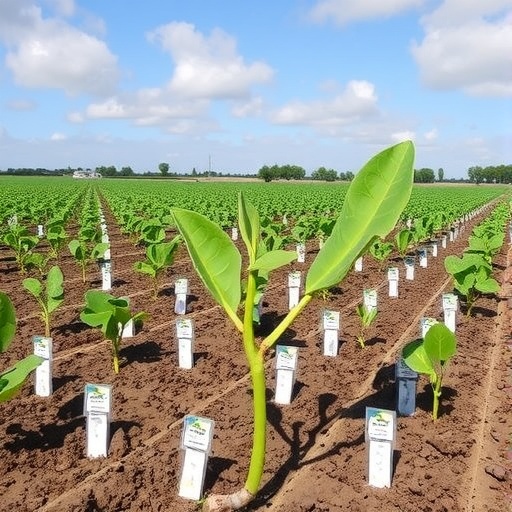In a groundbreaking study, researchers investigated the impact of drought stress on cowpea, scientifically known as Vigna unguiculata, revealing significant alterations in various physiological and metabolic processes. Drought is a formidable environmental challenge that can severely hinder crop productivity. In the case of cowpeas, understanding how these plants adapt to water scarcity is crucial, as they are an important source of protein and facilitate food security, particularly in arid and semi-arid regions.
The research team, led by Sanusi et al., meticulously analyzed the changes that occur in cowpeas when subjected to drought conditions. They focused on the metrics of photosynthesis, hormonal balance, water potential, and metabolomic profiles, components that are vital for the growth and development of the plant. The results shed light on the intricate mechanisms that allow cowpeas to cope with the limitations imposed by water deficits, providing insights that could lead to more resilient crop varieties.
Photosynthesis serves as a fundamental process through which plants convert light energy into chemical energy, ultimately supporting their growth. The study revealed that drought stress led to a notable decline in photosynthetic efficiency in cowpeas. Leaves, which are the primary sites of photosynthesis, exhibited reduced chlorophyll content and altered stomatal conductance under drought conditions. This reduction in photosynthetic activity poses a risk to the plant’s overall energy budget, highlighting the delicate balance that must be maintained even in challenging environments.
Another area of investigation was the hormonal balance within cowpeas and how it is influenced by drought stress. The study found that the levels of critical plant hormones such as abscisic acid (ABA), auxins, and cytokinins shifted significantly in response to water scarcity. This hormonal response is part of the plant’s adaptive mechanism, allowing it to regulate processes such as stomatal closure and root growth. The shift in hormone levels indicates a complex interplay of signals that help the plant manage its water use efficiency and resilience against stress.
In addition to photosynthesis and hormonal balance, the research examined the water potential of cowpea plants under drought conditions. Water potential is a measure of the availability of water in the plant, impacting processes such as nutrient uptake and cellular functionality. With decreased soil moisture, the water potential within the plant tissues was adversely affected, leading to signs of wilting and stress. Understanding these changes is crucial for developing effective irrigation strategies and improving the drought resistance of cowpeas.
Metabolomic profiling offered another layer of insight into the drought response of cowpeas. The researchers employed sophisticated analytical techniques to identify and quantify various metabolites that play key roles in stress responses. Changes in metabolite levels reflect the metabolic adjustments the plant makes when facing water scarcity. For instance, the accumulation of osmoprotectants was observed, which serve to protect cellular structures and maintain metabolic functions during periods of low water availability.
As climate change exacerbates the occurrence of droughts globally, the findings from this research are more relevant than ever. By elucidating the physiological and biochemical pathways through which cowpeas respond to drought stress, the study opens the door to potential agricultural advancements. The insights gained can inform breeding programs aimed at developing new cowpea cultivars that are better equipped to withstand the challenges posed by changing climatic conditions.
Moreover, the implications of this research extend beyond cowpeas. The adaptive strategies identified could be utilized to enhance drought resilience in other crops, contributing to global food security. As scientists and agriculturalists strive to mitigate the impacts of climatic variability, understanding plants’ responses to water stress becomes paramount.
In summary, Sanusi et al.’s research paints a comprehensive picture of how drought stress activates a cascade of physiological and biochemical changes in cowpea plants. These findings not only contribute to our understanding of plant resilience mechanisms but also represent a critical step toward developing more sustainable agricultural practices.
By disseminating this knowledge, the scientific community can work collaboratively to address the pressing challenge of food security in the face of a changing climate. The successful adaptation of crops like cowpeas to drought conditions serves as a model for future research aiming to enhance the resilience of various agricultural systems.
The data gathered from this study reinforces the importance of continued investment in plant research, particularly for crops that are crucial for the livelihoods of millions of people worldwide. As researchers continue to explore the depths of plant responses to environmental stresses, the potential for innovation in agricultural practices remains vast and promising.
Formal education and public awareness of these findings will be essential for integrating this knowledge into effective agricultural practices. Stakeholders, including farmers, policymakers, and researchers, must collaborate to share these insights widely. Only through a collective approach can we hope to transform agricultural landscapes and ensure that crops are able to thrive under the impending challenges posed by climate change.
By fostering a deeper understanding of how crops like cowpeas adapt to drought, we pave the way for a more resilient agricultural future, ultimately enhancing our capacity to feed a growing global population.
Subject of Research: Effects of drought stress on cowpeas
Article Title: Drought stress induces alterations in photosynthesis, hormonal balance, water potential, and metabolomic profiles in cowpea (Vigna unguiculata)
Article References:
Sanusi, B., Mutalib, M.O., Maiwada, F.S. et al. Drought stress induces alterations in photosynthesis, hormonal balance, water potential, and metabolomic profiles in cowpea (Vigna unguiculata).
Discov. Plants 2, 285 (2025). https://doi.org/10.1007/s44372-025-00368-0
Image Credits: AI Generated
DOI: 10.1007/s44372-025-00368-0
Keywords: Cowpea, drought stress, photosynthesis, hormonal balance, water potential, metabolomics, climate change, food security, agricultural resilience.




